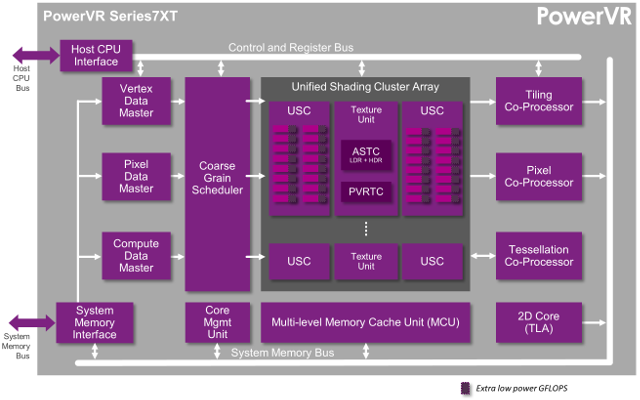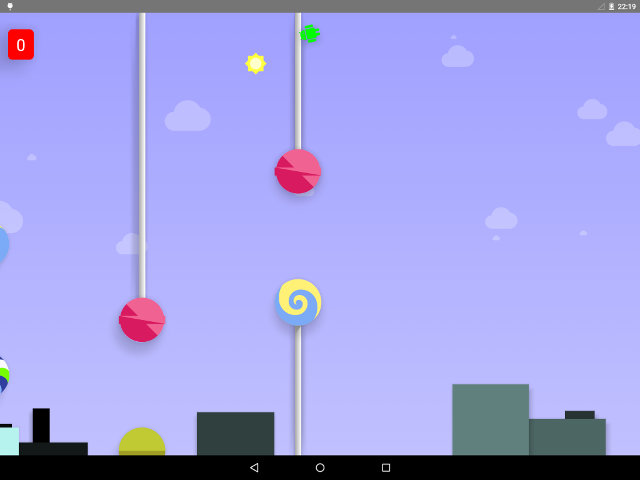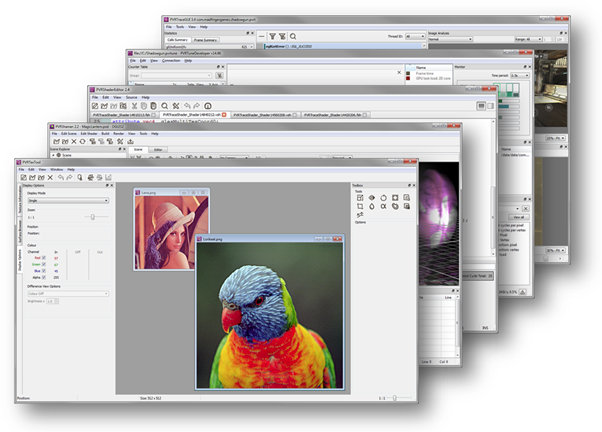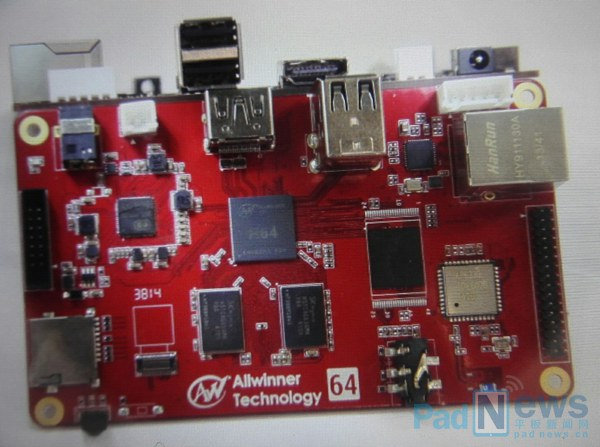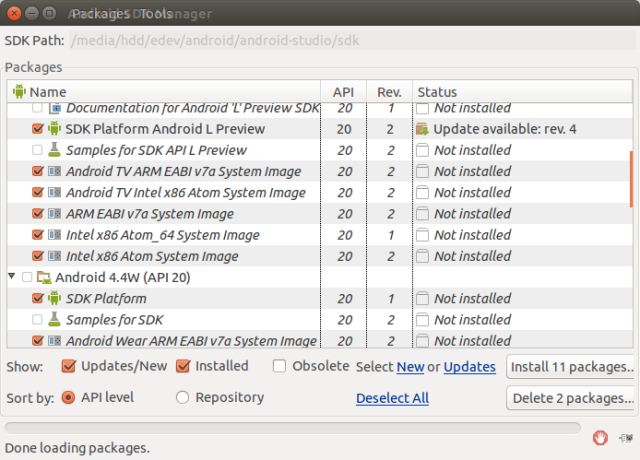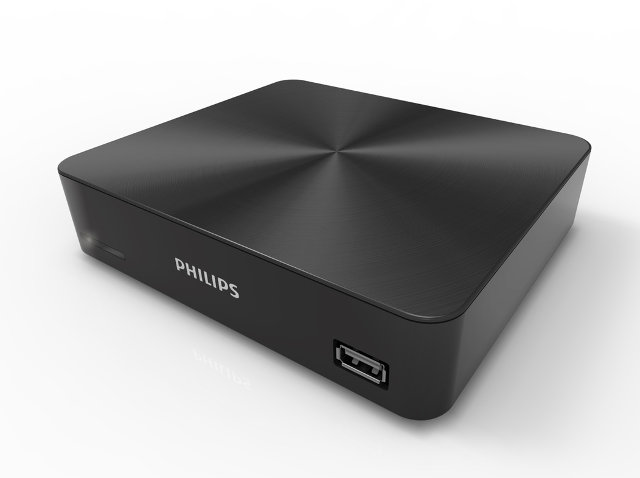Imagination Technologies has announced a new PowerVR Series7 GPU architecture that will be used in their high end PowerVR Series7XT GPUs delivering up to 1.5 TFLOPS for mid range and high-end mobioe devices, set-top boxes, gaming consoles and even servers, as well as their low power lost cost PowerVR Series7XE GPUs for entry-level mobile devices, set-top boxes, and wearables. PowerVR Series7 GPU, both Series7XT and Series7XE GPUs, can achieve up to a 60% performance improvement over PowerVR Series6XT/6XE GPUs for a given configuration. For example a 64-core PowerVR7XT GPU should be up to 60% faster than a 64-core PowerVR Series6XT clocked at the same frequency, with all extra performance due to a different and improved architecture. Some of Series7 architectural enhancements include: Instruction set enhancements including added co-issue capability, resulting in improved application performance and increased GPU efficiency New hierarchical layout structure that enables scalable polygon throughput and pixel fillrate […]
Android 5.0 Lollipop Now Boots on Rockchip RK3188 Tablets
Android 5.0 source code was pushed to AOSP less than a week ago, but oma7144, a member of Arctablet CrewRKTablets, already managed to have a preliminary firmware boot on Odys Iron, a tablet powered by Rockchip RK3188. This is still work in progress, and the firmware image has not been made available for download, but it looks promising, and that means Android Lollipop firmware images for Rockchip tablets and mini PCs could be released sooner than I initially expected. Some screenshots taken from the tablet. You can find more screenshots on Arctablet. Via Google+ Mini PC community. Jean-Luc Aufranc (CNXSoft)Jean-Luc started CNX Software in 2010 as a part-time endeavor, before quitting his job as a software engineering manager, and starting to write daily news, and reviews full time later in 2011. www.cnx-software.com
Android 5.0 Lollipop Source Code Pushed to AOSP
As Nexus 6 smartphone, Nexus 6 tablet, and Nexus Player have now started to ship, Google has pushed Android Lollipop to AOSP (Android Open Source Project), as well as images for Nexus 4, Nexus 5, Nexus 7 (2012 and 2013), and Nexus 10. You’ll soon be able to retrieve the source code with the following command lines [Update: I still can’t use the lollipop-release branch to retrieve the code, so instead you can use android-5.0.0_r1 tag for Nexus 9, or android-5.0.0_r2 tag for Nexus Player / Android TV]: repo init -u https://android.googlesource.com/platform/manifest -b android-5.0.0_r1 repo sync Currently repo init fails with: error: in init -u https://android.googlesource.com/platform/manifest -b lollipop-release –repo-url=https://gerrit.googlesource.com/git-repo –repo-branch=stable: revision lollipop-release in manifests not found But everything should come online soon. In the meantime, you could still browse the code. Anyway that means Android 5.0 images for mini PCs, TV boxes and other devices will hopefully be available in […]
PowerVR SDK v3.4 Supports WebGL, 64-Bit Android 5.0 Lollipop, and MIPS Linux
Imagination Technolgies has just released PowerVR SDK v3.4 including the latest compilers for PowerVR Series6 and Series6XT GPUs to PVRShaderEditor, several performance optimization, a new WebGL SDK, 64-bit support for Android 5.0 Lollipop, and Linux support for MIPS based processors. The company has revamped the user interfaces of their tools, and made the following key changes: PVRTrace, a tool to capture and analyze OpenGL ES and EGL API calls, now supports OpenGL ES 3.1, compressed trace files, and they’ve reduce the software memory usage PVRTune, a performance analysis tool, now features new counters, and “significant” performance optimizations. PVRShaderEditor, a light-weight shader editing too, adds the latest compilers for PowerVR Series6 (FP32 and FP16) and Series6XT GPUs, as well as GLSL disassembler output. PVRTexTool, a utility for compressing textures, adds plugin support for Autodesk 3DSMax and Maya (2015 versions), and improves ETC decompression by up to 20% faster per surface. Imagination also […]
Google Unveils Android 5.0 Lollipop, Nexus 6 Smartphone, Nexus 9 Tablet, and Nexus Player
Android L is now formally known as Android Lollipop. Since Google already released Android L preview a few month ago, we already know what’s new in Android 5.0 Lollipop with key changes including material design user interface, ART replacing Dalvik, better battery management, 64-bit support, etc… Google also announced three hardware platforms running Android 5.0: Nexus 6 Smartphone, Nexus 9 Tablet, and Nexus Player (Android TV) Motorola Nexus 6 Smartphone Hardware specifications: SoC – Qualcomm Snapdragon 805 quad core Krait 450 processor @ 2.7 GHz with Adreno 420 GPU System Memory – 3GB RAM Storage – 32 or 64 GB eMMC – No micro SD slot Display – 5.96” 1440×2560 AMOLED display (493 ppi). 16:9 Aspect ratio. Connectivity – 802.11 ac 2×2 (MIMO), Bluetooth 4.1, NFC Cellular Network (nano SIM): North America: GSM – 850/900/1800/1900MHz CDMA Band Class – 0/1/10 WCDMA Bands – 1/2/4/5/8 LTE Bands – 2/3/4/5/7/12/13/17/25/26/29/41 CA DL Bands […]
Allwinner H64 based Nobel64 Could the First Affordable 64-bit ARM Development Board
Based on the comments I read on this blog many people are early waiting for 64-bit ARM boards. There are already ARMv8 server boards by Applied Micro, AMD and others, but these cost several thousand dollars and are not sold to individuals, and ARM recently launched Juno development board, but it should be well over the budget of most hobbyists too. But the wait may soon be over, as Padnews found out Allwinner and Merrii Technology showcased Nobel64 development board powered by a yet to be announced Allwinner H64 64-bit ARM SoC at the Hong Kong Electronics Fair. Nobel64 development board specifications: SoC – Allwinner H64 quad core 64-bit ARM processor, most probably based on Cortex A53 cores. System Memory – 2GB DDR3 Storage – 16 GB eMMC + micro SD card slot Video / Audio Output – HDMI 1.4 + AV port. Connectivity – Gigabit Ethernet, dual band Wi-Fi, […]
Android L x86 64-bit Developer Preview Emulator Image Released
Several weeks ago Linaro posted instructions to run Android L ARM 64-bit in QEMU which takes some efforts to setup, and at the time lacked OpenGL support (not sure about the status now). Google has now releases their own 64-bit Android L preview image for the x86 emulator, and hopefully they’ll release a 64-bit ARM image and NDK sometimes in the near future, as 64-bit mobile devices are expected for Q1 2015. That means developers can now test the 64-bit version of their apps build for x86 using Google emulator. Java only apps should most probably work without issues, but apps relying on native code (C/C++/assembler) will certainly require a little bit more work. The latest Android NDK (r10b) support 64-bit code, and apps can be built with x86_64 build target, or using APP_ABI=all64 in Application.mk. 64-bit support increases addressable memory space, provides a larger number of registers, and new instruction […]
TP Vision Announces Philips UHD 880 Media Player Running Android L for Philips UHD Televisions
TV Vision has unveiled a new 4K media player to bring HEVC streaming capabilities to Philips UHD TVs at IFA 2014 in Berlin. The device will be based on Android L, and is said to be compatible with all 2013 and 2014 Philips UHD TVs. It should be compatible with other 4K TVs as well, but they mention some limitations due to HDCP, and some 2013 Philips TV will only handle 4K at 30 fps. Another interesting point is that if you have bought a recent Philips UHD TV, this media player may be free of charge. The specs are not complete, but here’s what we know: SoC – N/A System Memory – N/A Storage – 12GB storage to install apps (So most probably a 16GB eMMC or NAND flash) Video Output – HDMI 2.0 with HDCP 1.4, HDCP 2.2 support Main Video Codecs and Containers – HEVC (up to […]


